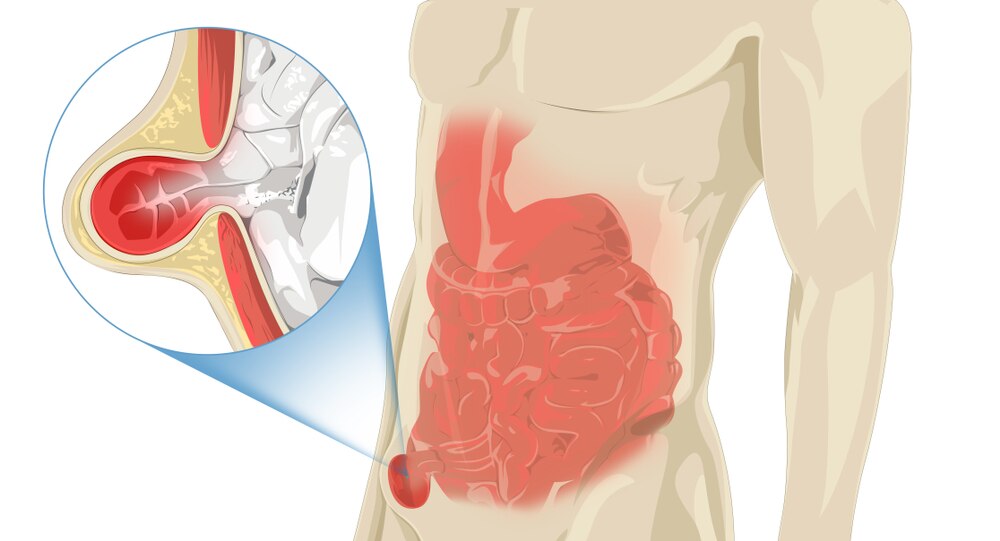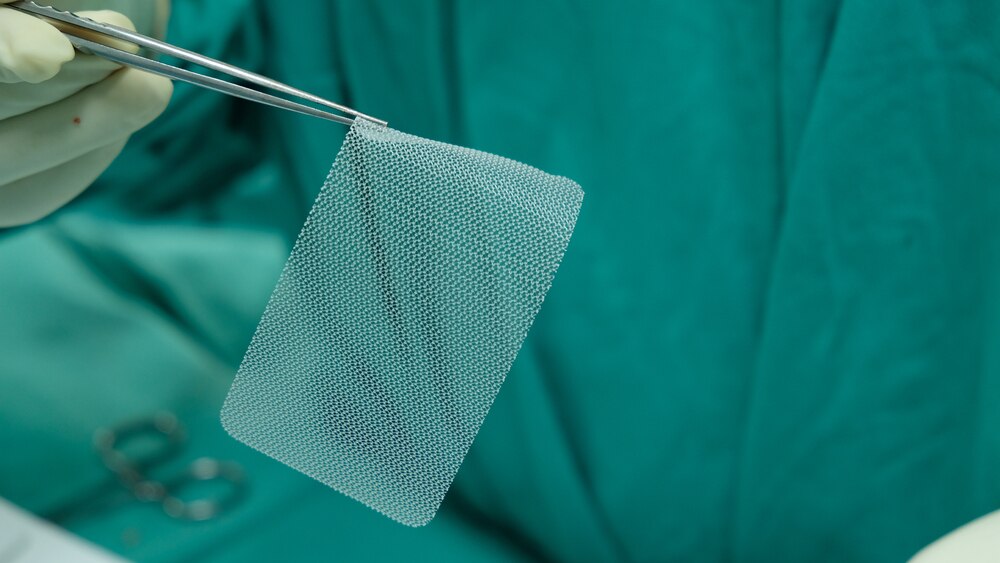Inguinal Hernia
On this page:
- What is an inguinal hernia?
- How common are inguinal hernias?
- Who is more likely to have an inguinal hernia?
- What are the complications of inguinal hernias?
- What are the symptoms of an inguinal hernia?
- What causes inguinal hernias?
- How do doctors diagnose inguinal hernias?
- What tests do doctors use to diagnose inguinal hernias?
- How do doctors treat inguinal hernias?
- How do doctors treat the complications of inguinal hernias?
- What can I expect after surgery to treat an inguinal hernia?
- What are the risks of hernia surgery?
- Clinical Trials for Inguinal Hernia
What is an inguinal hernia?
An inguinal hernia is a bulging of the contents of the abdomen through a weak area in the lower abdominal wall. Inguinal hernias can occur at either of two passages through the lower abdominal wall, one on each side of the groin. These passages are called inguinal canals. Inguinal hernias can also occur through two deeper passages in the groin called the femoral canals. Hernias through these passages are also known as femoral hernias.
Inguinal hernias most often contain fat or part of the small intestine. In girls or women, inguinal hernias may contain part of the female reproductive system, such as an ovary. When an inguinal hernia occurs, part of the peritoneum—the lining of the abdominal cavity—bulges through the abdominal wall and forms a sac around the hernia.
Inguinal hernias may slide in and out of the abdominal wall. A doctor can often move an inguinal hernia back inside the abdominal wall with gentle massage.
Inguinal hernias typically develop on one side of the groin and form on the right side more often than on the left. Some people who have an inguinal hernia on one side will have or will develop a hernia on the other side.

How common are inguinal hernias?
Inguinal hernias are relatively common. Researchers estimate that about 27 percent of men and 3 percent of women will develop an inguinal hernia at some point in their lives.1
Who is more likely to have an inguinal hernia?
Inguinal hernias are more common in certain age groups.
- Among adults, the chance of having an inguinal hernia increases with age, and inguinal hernias are most common in people ages of 75 to 80.2
- Among children, inguinal hernias are most common in those between the ages of 0 and 5 years.2
- Among infants, inguinal hernias are more common in premature infants.3
Inguinal hernias are also more common in4
- males, who are 8 to 10 times more likely than women to develop inguinal hernias
- males who have had prostatectomy
- people with a family history of inguinal hernias
- people who have a lower body mass index (BMI)
- people who have connective tissue disorders
What are the complications of inguinal hernias?
Inguinal hernias may become stuck, or incarcerated, meaning the contents of the hernia that bulge through the abdominal wall cannot be massaged back inside the abdominal wall.
If a hernia becomes stuck outside the abdominal wall, it may become strangulated, meaning the blood flow to the hernia is cut off. Lack of blood flow can cause the death of tissues inside the hernia.
If a hernia that contains part of the small intestine becomes stuck and strangulated, this can lead to intestinal obstruction and death of the strangulated part of the intestine.
What are the symptoms of an inguinal hernia?
Symptoms of an inguinal hernia may include
- a bulge in the groin—the area between the lower abdomen and thighs
- a bulge in the scrotum in a male
- feelings of discomfort, pain, heaviness, or burning in the groin
Your symptoms may get worse when you strain, lift, cough, or stand for a long time and may get better when you rest or lie down.
Seek medical help right away
If you have symptoms of a stuck or strangulated hernia, seek medical help right away. A strangulated hernia is a life-threatening condition.
Symptoms of stuck or strangulated hernias may include
- a hernia bulge that is suddenly larger than before
- a hernia bulge that used to go back inside the abdomen but no longer does
- fever
- redness in the area of the hernia
- sudden or severe pain or tenderness in the area of the hernia
- symptoms of intestinal obstruction, such as abdominal pain, bloating, nausea, and vomiting
What causes inguinal hernias?
A weak area in the muscles and connective tissue of the lower abdominal wall at the inguinal canal allows an inguinal hernia to develop. A hernia can form in different ways, causing two types of hernias.
- Indirect inguinal hernias are related to a defect in the lower abdominal wall that is present at birth. In a developing fetus, the inguinal canals have openings inside the abdomen that typically close before birth. In some cases, one or both openings remain open. Contents of the abdomen may bulge through this opening, causing a hernia. While the defect is present at birth, an indirect inguinal hernia may not occur until many years later.
- Direct inguinal hernias are related to a weak area in the inguinal canal wall that develops later in life. Contents of the abdomen may bulge out through this weak area, causing a hernia. This type of hernia primarily occurs in men. Women and children rarely develop this type of hernia.
Researchers are studying other factors that might play a role in causing inguinal hernias. These factors include
- connective tissue that is weaker than normal or connective tissue disorders
- genes that increase the risk of inguinal hernias
- health conditions that cause increased pressure inside the abdomen, such as chronic cough or chronic constipation
- regular or repeated activities that cause increased pressure inside the abdomen, such as heavy lifting and standing or walking for many hours each day at work
How do doctors diagnose inguinal hernias?
To diagnose an inguinal hernia, your doctor will ask about your medical history and symptoms and perform a physical exam. In some cases, doctors also order imaging tests.
During a physical exam, the doctor will examine your abdomen. The doctor may ask you to stand, cough, or strain while he or she checks for a bulge caused by the hernia. The doctor may try to gently massage the contents of the hernia back into the abdomen.

What tests do doctors use to diagnose inguinal hernias?
If the diagnosis is not clear after a physical exam, your doctor may order imaging tests to check for an inguinal hernia. Doctors may also use imaging tests to check for complications.
Imaging tests may include
- ultrasound, which uses sound waves to create an image of your organs
- computed tomography (CT), which uses a combination of x-rays and computer technology to create images
- magnetic resonance imaging (MRI), which takes pictures of your body’s internal organs and soft tissues without using x-rays
How do doctors treat inguinal hernias?
Most people with inguinal hernias will need surgery to repair the hernia. Several different types of open and laparoscopic hernia surgery are available. The type of surgery your doctor recommends may depend on factors such as the size of the hernia and your age, health, and medical history.
Open hernia surgery
In open hernia surgery, a surgeon makes a cut in your groin to view and repair the hernia. After repairing the hernia, surgeons typically use stitches and a piece of mesh to close the abdominal wall. The mesh strengthens the weak area where the hernia occurred. In some cases, surgeons may use stitches alone to close and strengthen the weak area in the abdominal wall.
Patients most often receive local anesthesia and a sedative for open hernia surgery. In some cases, doctors may give patients general anesthesia or a spinal block to make the body numb from the waist down.
Laparoscopic hernia surgery
In laparoscopic hernia surgery, a surgeon makes several small cuts in your lower abdomen and inserts special tools to view and repair the hernia. The surgeon uses a piece of mesh to close and strengthen the abdominal wall.
Patients most often receive general anesthesia for laparoscopic hernia surgery. Recovery time after laparoscopic surgery may be shorter than after open hernia surgery.

Watchful waiting
Research suggests that men with inguinal hernias that cause few or no symptoms may be able to safely delay surgery, an approach called watchful waiting.4,5 Men who delay surgery should watch for symptoms and see a doctor regularly. About 70 percent of men who delay surgery will develop new or worsening symptoms and will need surgery within 5 years.4
How do doctors treat the complications of inguinal hernias?
If an inguinal hernia causes complications, such as becoming stuck or strangulated, you will need emergency surgery to repair the hernia and treat the complications.
What can I expect after surgery to treat an inguinal hernia?
You may have some pain or discomfort after hernia surgery. The pain is typically mild and goes away within 2 weeks after surgery.4 Your doctor will recommend medicines to relieve pain.
Talk with your doctor about when you can safely return to your usual activities after hernia surgery. Many people can go back to work and resume daily activities within 3 to 5 days after hernia surgery.4
What are the risks of hernia surgery?
Surgery to repair an inguinal hernia is quite safe. However, possible complications of hernia surgery include
- urinary retention
- infection
- swelling in the area you had surgery due to a buildup of blood, called a hematoma, or a buildup of blood plasma, called a seroma
- chronic or severe pain
- return of the hernia, which may require another surgery
Serious complications, such as damage to blood vessels or organs, are rare.
Talk with your doctor about the risks of hernia surgery and symptoms you should watch for after surgery. For example, you should call your doctor right away if you have
- bleeding, drainage, or redness in the area where you had surgery
- fever or chills
- nausea or vomiting
- pain or swelling in your abdomen
- pain or swelling in your groin that gets worse
- pain that is severe or doesn’t get better when you take pain medicines
- problems breathing
- problems urinating
Clinical Trials for Inguinal Hernia
The NIDDK conducts and supports clinical trials in many diseases and conditions, including digestive diseases. The trials look to find new ways to prevent, detect, or treat disease and improve quality of life.
What are clinical trials for inguinal hernia?
Clinical trials—and other types of clinical studies—are part of medical research and involve people like you. When you volunteer to take part in a clinical study, you help doctors and researchers learn more about disease and improve health care for people in the future.
Researchers are studying many aspects of inguinal hernias, such as
- the safest time to perform surgery in premature infants born with inguinal hernias
- the likelihood that infants born with an abdominal wall defect will develop an inguinal hernia during childhood
- ways to manage pain without opioids after hernia surgery
- strategies to reduce hernia surgery complications, such as urinary retention
Find out if clinical studies are right for you.
Watch a video of NIDDK Director Dr. Griffin P. Rodgers explaining the importance of participating in clinical trials.
What clinical studies for inguinal hernias are looking for participants?
You can find clinical studies on inguinal hernias at ClinicalTrials.gov. In addition to searching for federally funded studies, you can expand or narrow your search to include clinical studies from industry, universities, and individuals; however, the NIH does not review these studies and cannot ensure they are safe. Always talk with your health care provider before you participate in a clinical study.
References
This content is provided as a service of the National Institute of Diabetes and Digestive and Kidney Diseases
(NIDDK), part of the National Institutes of Health. NIDDK translates and disseminates research findings to increase knowledge and understanding about health and disease among patients, health professionals, and the public. Content produced by NIDDK is carefully reviewed by NIDDK scientists and other experts.
The NIDDK would like to thank:
Neal E. Seymour, M.D., University of Massachusetts Medical School-Baystate

